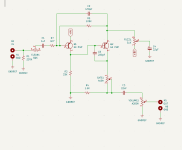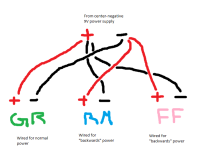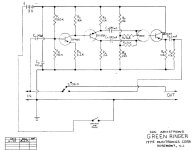MBFX
Well-known member
Hello again everyone! Harvest is nearly over, the vines are dropping their leaves, and I am getting my life back, which means the pedal building will ramp back up. My obsession recently has been making the perfect vintage combo pedal for my favorite tube amp. Through lots of experimentation and parts orders I have narrowed this down to a Ge Fuzz Face into a Ge Rangemaster, a la AnalogMan Sun Lion, into a Ge diode Green Ringer. The combo sounds incredible on my breadboards, has surprisingly low noise, and I am ready to box all three up into a single 1590XX enclosure with three footswitches a la Hoof Reaper. The problem is, The FF and RM need center-negative power, and the GR needs center-positive power. I can't flip the FF and RM circuits due to bad oscillation.
Since I can wire up a PNP FF/RM and power it with a 9V by connecting the power leads backwards, I assume that will work inside a pedal with a power supply. My plan is to use a center-negative power supply, and connect the FF and RM boards to it backwards, so that ground is positive. the GR board will be connected normally.
Is that going to cause some sort of problem I'm not anticipating, since the power will be tapped from a single source instead of separate, isolated supplies? I know electrons don't care which way they are flowing, but maybe someone has tried something like this and knows something I don't. I'm worried about noise or oscillation.
Since I can wire up a PNP FF/RM and power it with a 9V by connecting the power leads backwards, I assume that will work inside a pedal with a power supply. My plan is to use a center-negative power supply, and connect the FF and RM boards to it backwards, so that ground is positive. the GR board will be connected normally.
Is that going to cause some sort of problem I'm not anticipating, since the power will be tapped from a single source instead of separate, isolated supplies? I know electrons don't care which way they are flowing, but maybe someone has tried something like this and knows something I don't. I'm worried about noise or oscillation.




